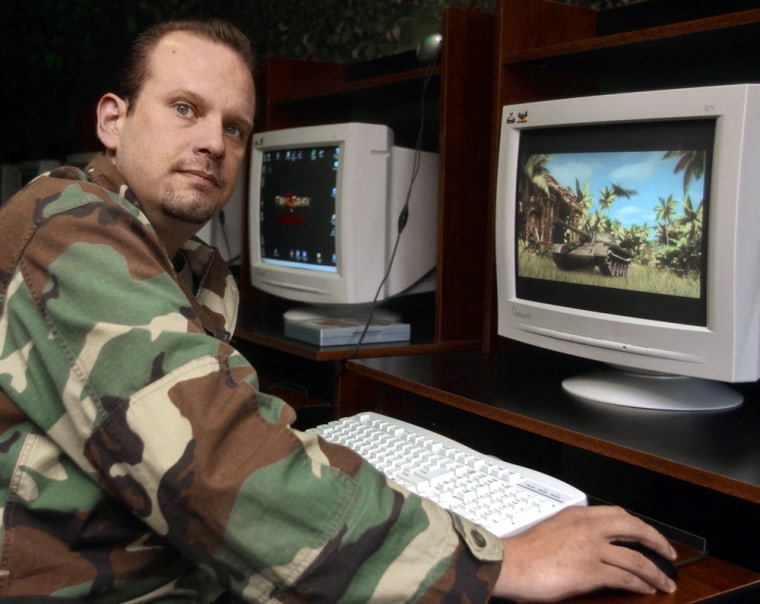Video game manufacturers often resort to techno-lingo to explain what they've done to make "Half-Life 2" more lifelike and "EverQuest 2" graphically stunning.
Techniques such as "normal maps," "pixel shaders" and "dynamic lighting" basically mean the newest game graphics are inching ever closer to the computer-animated movie "Shrek 2."
But there's another pricey reason for these good looks: gobs of computer horsepower.
Every year, new games push the envelope and require faster processors, more memory and better graphics cards. The games previewed at this year's Electronic Entertainment Expo continued that trend as they dazzled gamers with unprecedented visual splendor.
Elaborate detail
Armor worn by a sword-wielding fighter in "EverQuest 2," for example, is more than a simple collection of silvery pixels. It has real depth, reflects sunlight and is curved and embossed with intricate detail that becomes more elaborate the closer you look.
At large industry trade shows like E3, companies often show games using advanced prototype computers from manufacturers seeking to boost their image with hardcore gamers.
These top-of-the-line machines from Alienware Corp., Dell Inc., Hewlett-Packard Co. and others are stuffed with super-fast processors, video cards and gigabytes of zippy memory. One of these monsters can easily fetch $3,000 or more.
Owners of consoles from Nintendo Co., Microsoft Corp. and Sony Corp., of course, don't have to bother getting better systems because they all have the same parts and can't be upgraded.
For PC gamers like Richard Ellis of Dallas, however, hot new games often mean costly trips to the computer store.
"I've seen previews for `Halo 2' and `Half-Life 2,' and seeing how wonderful they looked, for me personally, all I could think is 'Oh, man, I'm going to have to spend another $2,000,'" Ellis said.
Ellis, 38, recently found performance drop for the massively multiplayer online game "Dark Age of Camelot" after he installed the "Trials of Atlantis" expansion pack. He ended up having to wait until he could afford a better graphics card.
Older systems out of luck
Shawn Carnes, a Blizzard Entertainment designer who is working on the online role-playing game "World of Warcraft," said the temptation to design games that push the computing envelope often means those with older systems are out of luck.
Developers often get "carried away with the power of the technology that they've been given," Carnes said, acknowledging that developers must be mindful of older systems to appeal to the largest audience possible.
As a professional gamer, 16-year-old Landon Ingrammson of Dallas gets his computer systems for free from the local computer shop that sponsors his equipment.
Good thing, too. Ingrammson guesses he'd have to spend a couple thousand dollars a year to keep up with always-rising demands.
Tweaks can be easily made so new games can work on wimpy computers, but they won't look the way they were meant to, he said.
Ingrammson agreed with Carnes that the problem could be avoided if game makers developed on slightly older computers. But games on middle-of-the-road computers usually aren't very impressive.
"They're trying to make the 'wow' effect of their games last longer," Ingrammson said. "It's the 'Oh my God, they did that?!' kind of thing."
Planning for the future
The swords and sorcery of Sony Online Entertainment's upcoming "EverQuest II" uses many of the latest graphical techniques.
At E3, Sony game designer Mario Rizzo demonstrated a group of five warriors swinging fiery swords and shooting luminescent spells at a giant winged dragon.
The dragon was richly drawn with multihued scales. Occasionally, it blurted flesh-burning acid that erupted from the dragon's mouth in a gust of swirling grey-green mist. In another scene, a moat ringing a magical castle rippled and undulated like actual water.
Rizzo said the game's minimum system requirements haven't been determined, but he expected them to be steep. That way, he said, the game will be "future proof" — looking fresh and visually appealing for as long as possible.
"We don't expect anybody to be able to run it right out of the box with full settings maxed," Rizzo said. "We're planning for the future."
